Improving Patient Safety: Nurse Leaders on Social Media Usage
VerifiedAdded on 2022/08/20
|8
|2056
|11
Report
AI Summary
This report examines the role of social media in nursing, particularly focusing on its impact on patient safety and the obligations of nurse leaders. The author, a newly graduated registered nurse, reflects on their experience leading a team to implement a quality improvement activity related to social media usage within the context of the Nursing and Midwifery Board of Australia (NMBA) guidelines. The report highlights the significance of the NMBA document 'Social Media: How to meet your obligations under the National Law' in ensuring patient safety by addressing issues such as confidentiality and professional boundaries. It also discusses the challenges faced by the author in leading a team, including a lack of familiarity with team members' skills, a multi-generational team dynamic, maintaining a healthy work culture, and increased work pressure. Finally, the report outlines strategies employed to manage these challenges, such as direct communication, team coaching, and task delegation, ultimately aiming to improve patient safety through the effective and responsible use of social media in nursing practices. References to relevant literature are included to support the discussion.
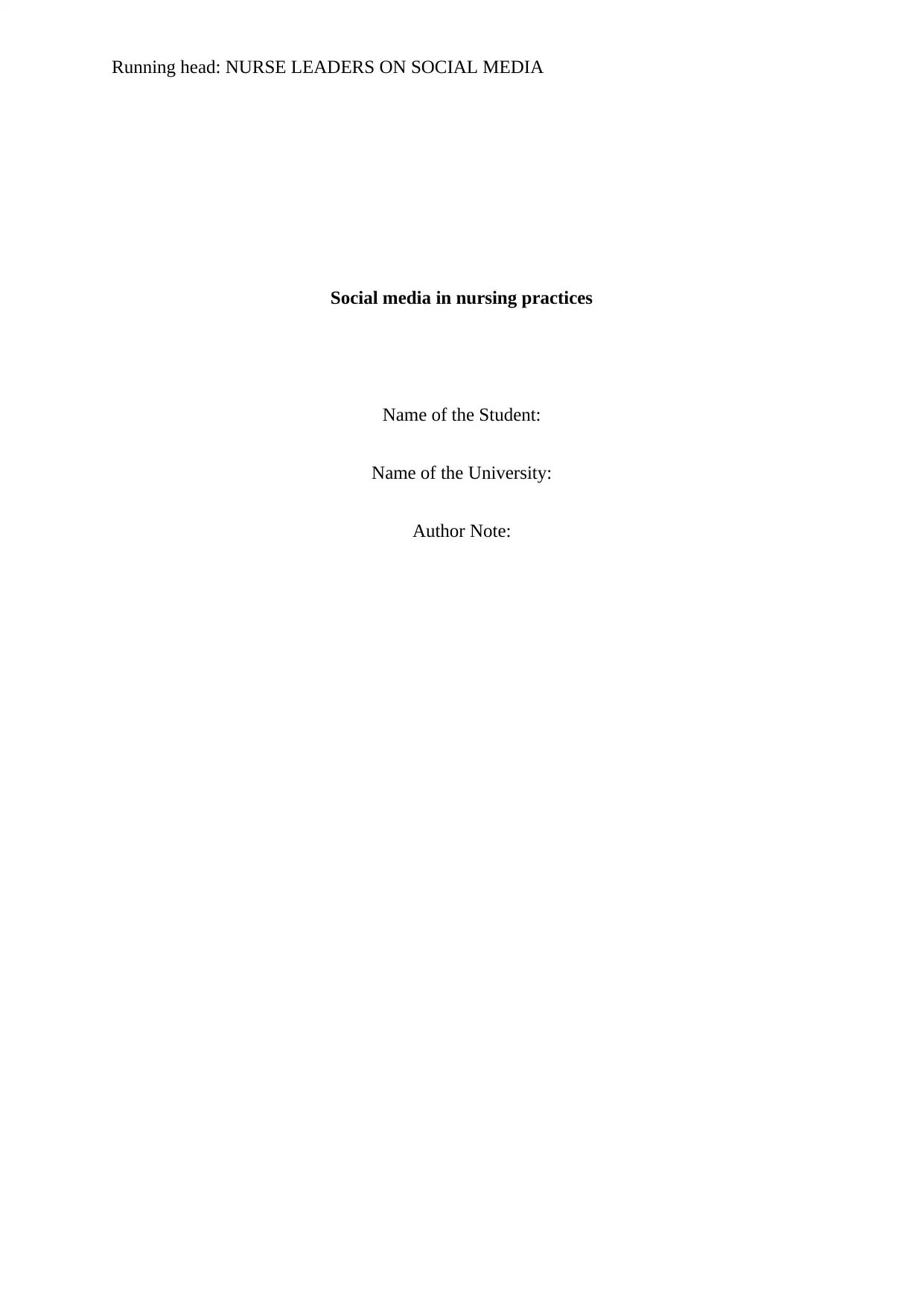
Running head: NURSE LEADERS ON SOCIAL MEDIA
Social media in nursing practices
Name of the Student:
Name of the University:
Author Note:
Social media in nursing practices
Name of the Student:
Name of the University:
Author Note:
Paraphrase This Document
Need a fresh take? Get an instant paraphrase of this document with our AI Paraphraser
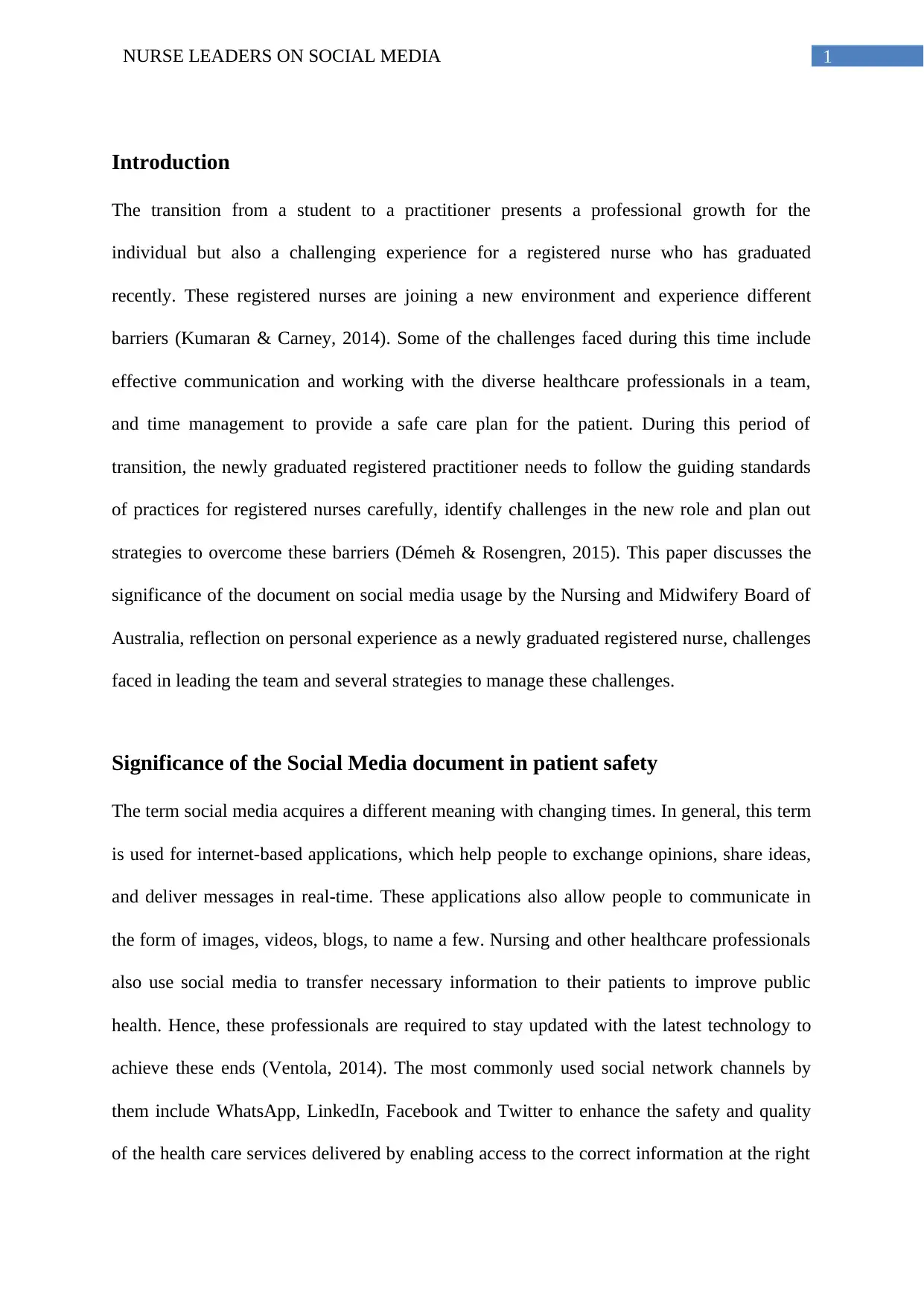
1NURSE LEADERS ON SOCIAL MEDIA
Introduction
The transition from a student to a practitioner presents a professional growth for the
individual but also a challenging experience for a registered nurse who has graduated
recently. These registered nurses are joining a new environment and experience different
barriers (Kumaran & Carney, 2014). Some of the challenges faced during this time include
effective communication and working with the diverse healthcare professionals in a team,
and time management to provide a safe care plan for the patient. During this period of
transition, the newly graduated registered practitioner needs to follow the guiding standards
of practices for registered nurses carefully, identify challenges in the new role and plan out
strategies to overcome these barriers (Démeh & Rosengren, 2015). This paper discusses the
significance of the document on social media usage by the Nursing and Midwifery Board of
Australia, reflection on personal experience as a newly graduated registered nurse, challenges
faced in leading the team and several strategies to manage these challenges.
Significance of the Social Media document in patient safety
The term social media acquires a different meaning with changing times. In general, this term
is used for internet-based applications, which help people to exchange opinions, share ideas,
and deliver messages in real-time. These applications also allow people to communicate in
the form of images, videos, blogs, to name a few. Nursing and other healthcare professionals
also use social media to transfer necessary information to their patients to improve public
health. Hence, these professionals are required to stay updated with the latest technology to
achieve these ends (Ventola, 2014). The most commonly used social network channels by
them include WhatsApp, LinkedIn, Facebook and Twitter to enhance the safety and quality
of the health care services delivered by enabling access to the correct information at the right
Introduction
The transition from a student to a practitioner presents a professional growth for the
individual but also a challenging experience for a registered nurse who has graduated
recently. These registered nurses are joining a new environment and experience different
barriers (Kumaran & Carney, 2014). Some of the challenges faced during this time include
effective communication and working with the diverse healthcare professionals in a team,
and time management to provide a safe care plan for the patient. During this period of
transition, the newly graduated registered practitioner needs to follow the guiding standards
of practices for registered nurses carefully, identify challenges in the new role and plan out
strategies to overcome these barriers (Démeh & Rosengren, 2015). This paper discusses the
significance of the document on social media usage by the Nursing and Midwifery Board of
Australia, reflection on personal experience as a newly graduated registered nurse, challenges
faced in leading the team and several strategies to manage these challenges.
Significance of the Social Media document in patient safety
The term social media acquires a different meaning with changing times. In general, this term
is used for internet-based applications, which help people to exchange opinions, share ideas,
and deliver messages in real-time. These applications also allow people to communicate in
the form of images, videos, blogs, to name a few. Nursing and other healthcare professionals
also use social media to transfer necessary information to their patients to improve public
health. Hence, these professionals are required to stay updated with the latest technology to
achieve these ends (Ventola, 2014). The most commonly used social network channels by
them include WhatsApp, LinkedIn, Facebook and Twitter to enhance the safety and quality
of the health care services delivered by enabling access to the correct information at the right
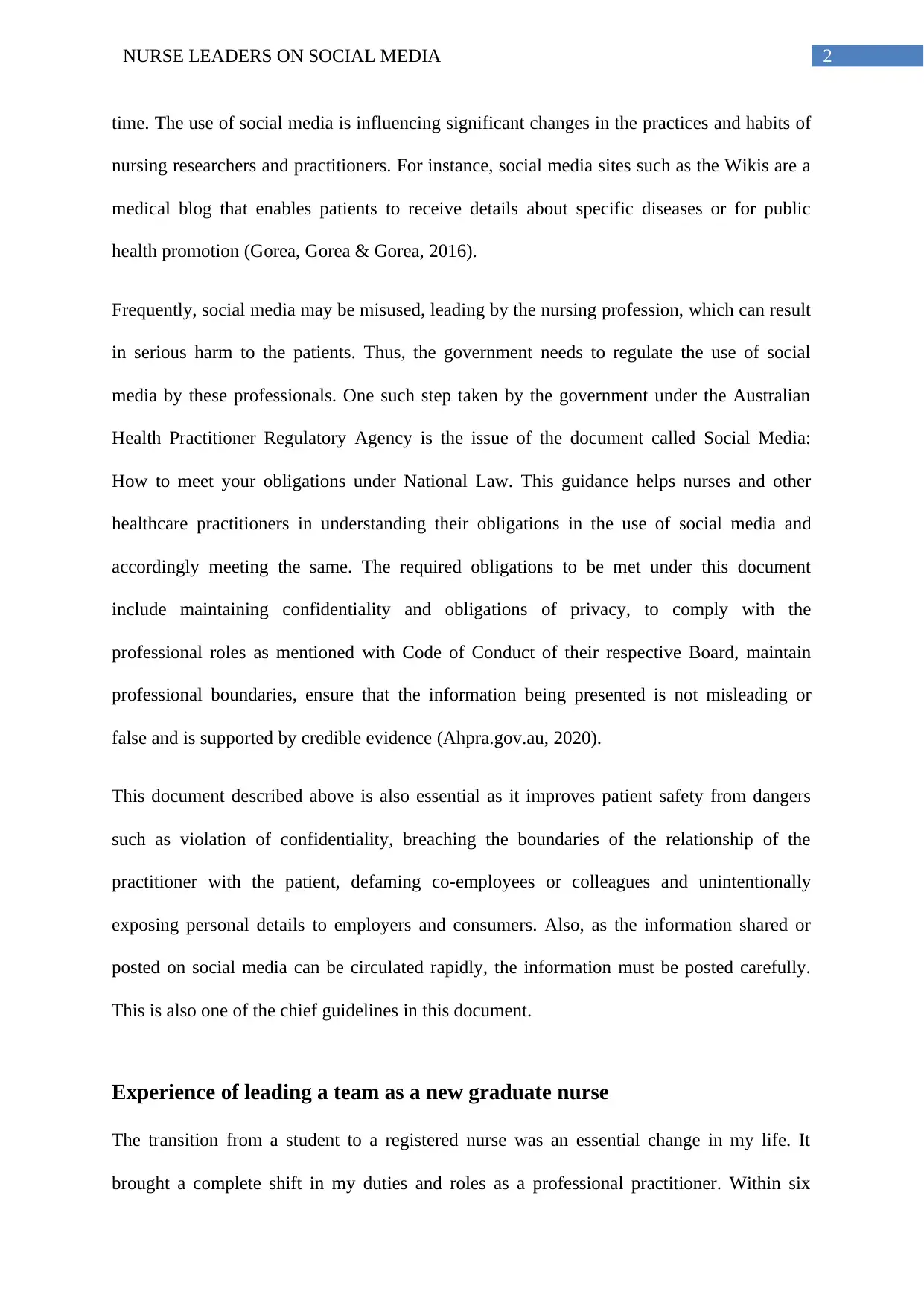
2NURSE LEADERS ON SOCIAL MEDIA
time. The use of social media is influencing significant changes in the practices and habits of
nursing researchers and practitioners. For instance, social media sites such as the Wikis are a
medical blog that enables patients to receive details about specific diseases or for public
health promotion (Gorea, Gorea & Gorea, 2016).
Frequently, social media may be misused, leading by the nursing profession, which can result
in serious harm to the patients. Thus, the government needs to regulate the use of social
media by these professionals. One such step taken by the government under the Australian
Health Practitioner Regulatory Agency is the issue of the document called Social Media:
How to meet your obligations under National Law. This guidance helps nurses and other
healthcare practitioners in understanding their obligations in the use of social media and
accordingly meeting the same. The required obligations to be met under this document
include maintaining confidentiality and obligations of privacy, to comply with the
professional roles as mentioned with Code of Conduct of their respective Board, maintain
professional boundaries, ensure that the information being presented is not misleading or
false and is supported by credible evidence (Ahpra.gov.au, 2020).
This document described above is also essential as it improves patient safety from dangers
such as violation of confidentiality, breaching the boundaries of the relationship of the
practitioner with the patient, defaming co-employees or colleagues and unintentionally
exposing personal details to employers and consumers. Also, as the information shared or
posted on social media can be circulated rapidly, the information must be posted carefully.
This is also one of the chief guidelines in this document.
Experience of leading a team as a new graduate nurse
The transition from a student to a registered nurse was an essential change in my life. It
brought a complete shift in my duties and roles as a professional practitioner. Within six
time. The use of social media is influencing significant changes in the practices and habits of
nursing researchers and practitioners. For instance, social media sites such as the Wikis are a
medical blog that enables patients to receive details about specific diseases or for public
health promotion (Gorea, Gorea & Gorea, 2016).
Frequently, social media may be misused, leading by the nursing profession, which can result
in serious harm to the patients. Thus, the government needs to regulate the use of social
media by these professionals. One such step taken by the government under the Australian
Health Practitioner Regulatory Agency is the issue of the document called Social Media:
How to meet your obligations under National Law. This guidance helps nurses and other
healthcare practitioners in understanding their obligations in the use of social media and
accordingly meeting the same. The required obligations to be met under this document
include maintaining confidentiality and obligations of privacy, to comply with the
professional roles as mentioned with Code of Conduct of their respective Board, maintain
professional boundaries, ensure that the information being presented is not misleading or
false and is supported by credible evidence (Ahpra.gov.au, 2020).
This document described above is also essential as it improves patient safety from dangers
such as violation of confidentiality, breaching the boundaries of the relationship of the
practitioner with the patient, defaming co-employees or colleagues and unintentionally
exposing personal details to employers and consumers. Also, as the information shared or
posted on social media can be circulated rapidly, the information must be posted carefully.
This is also one of the chief guidelines in this document.
Experience of leading a team as a new graduate nurse
The transition from a student to a registered nurse was an essential change in my life. It
brought a complete shift in my duties and roles as a professional practitioner. Within six
⊘ This is a preview!⊘
Do you want full access?
Subscribe today to unlock all pages.

Trusted by 1+ million students worldwide
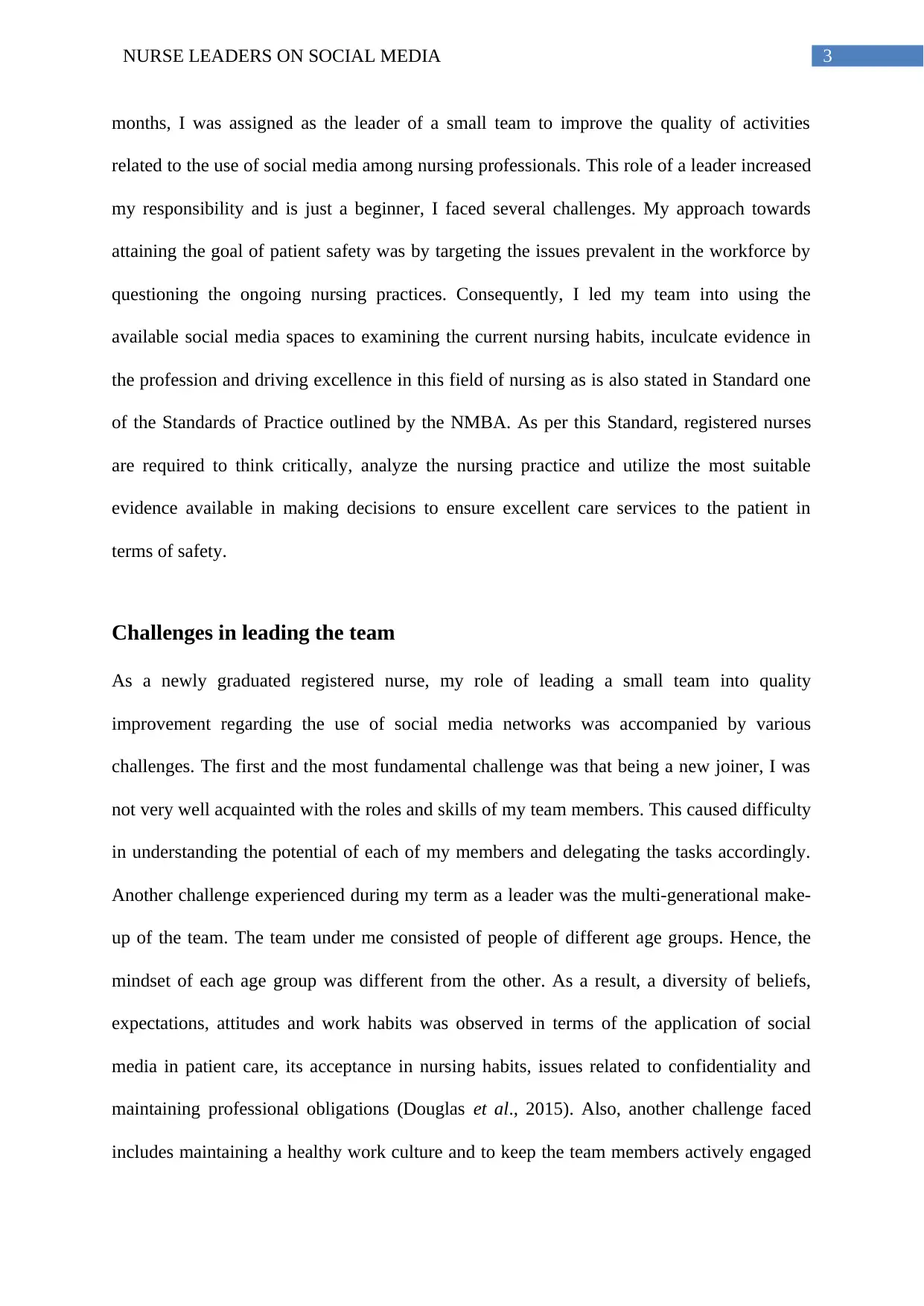
3NURSE LEADERS ON SOCIAL MEDIA
months, I was assigned as the leader of a small team to improve the quality of activities
related to the use of social media among nursing professionals. This role of a leader increased
my responsibility and is just a beginner, I faced several challenges. My approach towards
attaining the goal of patient safety was by targeting the issues prevalent in the workforce by
questioning the ongoing nursing practices. Consequently, I led my team into using the
available social media spaces to examining the current nursing habits, inculcate evidence in
the profession and driving excellence in this field of nursing as is also stated in Standard one
of the Standards of Practice outlined by the NMBA. As per this Standard, registered nurses
are required to think critically, analyze the nursing practice and utilize the most suitable
evidence available in making decisions to ensure excellent care services to the patient in
terms of safety.
Challenges in leading the team
As a newly graduated registered nurse, my role of leading a small team into quality
improvement regarding the use of social media networks was accompanied by various
challenges. The first and the most fundamental challenge was that being a new joiner, I was
not very well acquainted with the roles and skills of my team members. This caused difficulty
in understanding the potential of each of my members and delegating the tasks accordingly.
Another challenge experienced during my term as a leader was the multi-generational make-
up of the team. The team under me consisted of people of different age groups. Hence, the
mindset of each age group was different from the other. As a result, a diversity of beliefs,
expectations, attitudes and work habits was observed in terms of the application of social
media in patient care, its acceptance in nursing habits, issues related to confidentiality and
maintaining professional obligations (Douglas et al., 2015). Also, another challenge faced
includes maintaining a healthy work culture and to keep the team members actively engaged
months, I was assigned as the leader of a small team to improve the quality of activities
related to the use of social media among nursing professionals. This role of a leader increased
my responsibility and is just a beginner, I faced several challenges. My approach towards
attaining the goal of patient safety was by targeting the issues prevalent in the workforce by
questioning the ongoing nursing practices. Consequently, I led my team into using the
available social media spaces to examining the current nursing habits, inculcate evidence in
the profession and driving excellence in this field of nursing as is also stated in Standard one
of the Standards of Practice outlined by the NMBA. As per this Standard, registered nurses
are required to think critically, analyze the nursing practice and utilize the most suitable
evidence available in making decisions to ensure excellent care services to the patient in
terms of safety.
Challenges in leading the team
As a newly graduated registered nurse, my role of leading a small team into quality
improvement regarding the use of social media networks was accompanied by various
challenges. The first and the most fundamental challenge was that being a new joiner, I was
not very well acquainted with the roles and skills of my team members. This caused difficulty
in understanding the potential of each of my members and delegating the tasks accordingly.
Another challenge experienced during my term as a leader was the multi-generational make-
up of the team. The team under me consisted of people of different age groups. Hence, the
mindset of each age group was different from the other. As a result, a diversity of beliefs,
expectations, attitudes and work habits was observed in terms of the application of social
media in patient care, its acceptance in nursing habits, issues related to confidentiality and
maintaining professional obligations (Douglas et al., 2015). Also, another challenge faced
includes maintaining a healthy work culture and to keep the team members actively engaged
Paraphrase This Document
Need a fresh take? Get an instant paraphrase of this document with our AI Paraphraser
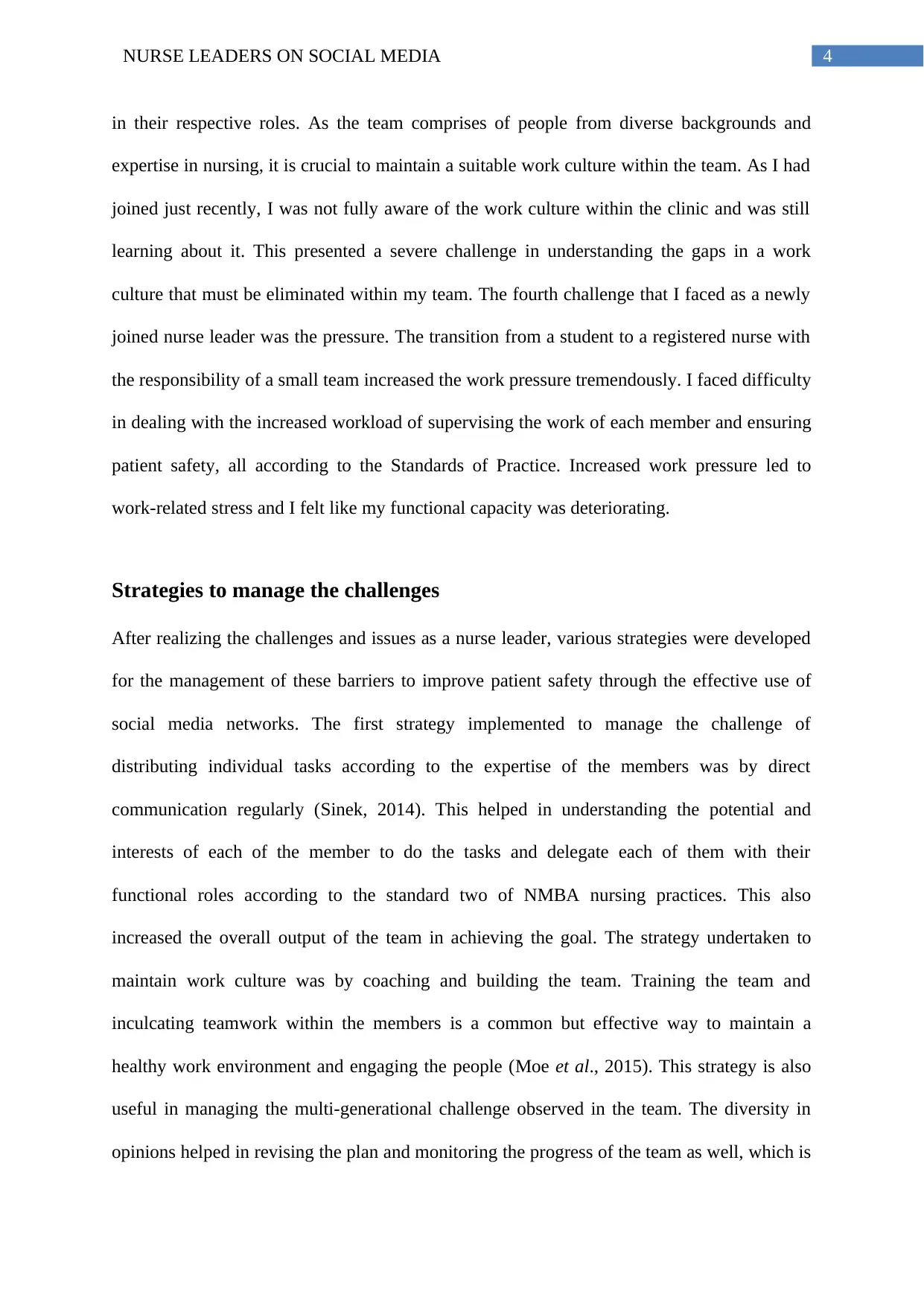
4NURSE LEADERS ON SOCIAL MEDIA
in their respective roles. As the team comprises of people from diverse backgrounds and
expertise in nursing, it is crucial to maintain a suitable work culture within the team. As I had
joined just recently, I was not fully aware of the work culture within the clinic and was still
learning about it. This presented a severe challenge in understanding the gaps in a work
culture that must be eliminated within my team. The fourth challenge that I faced as a newly
joined nurse leader was the pressure. The transition from a student to a registered nurse with
the responsibility of a small team increased the work pressure tremendously. I faced difficulty
in dealing with the increased workload of supervising the work of each member and ensuring
patient safety, all according to the Standards of Practice. Increased work pressure led to
work-related stress and I felt like my functional capacity was deteriorating.
Strategies to manage the challenges
After realizing the challenges and issues as a nurse leader, various strategies were developed
for the management of these barriers to improve patient safety through the effective use of
social media networks. The first strategy implemented to manage the challenge of
distributing individual tasks according to the expertise of the members was by direct
communication regularly (Sinek, 2014). This helped in understanding the potential and
interests of each of the member to do the tasks and delegate each of them with their
functional roles according to the standard two of NMBA nursing practices. This also
increased the overall output of the team in achieving the goal. The strategy undertaken to
maintain work culture was by coaching and building the team. Training the team and
inculcating teamwork within the members is a common but effective way to maintain a
healthy work environment and engaging the people (Moe et al., 2015). This strategy is also
useful in managing the multi-generational challenge observed in the team. The diversity in
opinions helped in revising the plan and monitoring the progress of the team as well, which is
in their respective roles. As the team comprises of people from diverse backgrounds and
expertise in nursing, it is crucial to maintain a suitable work culture within the team. As I had
joined just recently, I was not fully aware of the work culture within the clinic and was still
learning about it. This presented a severe challenge in understanding the gaps in a work
culture that must be eliminated within my team. The fourth challenge that I faced as a newly
joined nurse leader was the pressure. The transition from a student to a registered nurse with
the responsibility of a small team increased the work pressure tremendously. I faced difficulty
in dealing with the increased workload of supervising the work of each member and ensuring
patient safety, all according to the Standards of Practice. Increased work pressure led to
work-related stress and I felt like my functional capacity was deteriorating.
Strategies to manage the challenges
After realizing the challenges and issues as a nurse leader, various strategies were developed
for the management of these barriers to improve patient safety through the effective use of
social media networks. The first strategy implemented to manage the challenge of
distributing individual tasks according to the expertise of the members was by direct
communication regularly (Sinek, 2014). This helped in understanding the potential and
interests of each of the member to do the tasks and delegate each of them with their
functional roles according to the standard two of NMBA nursing practices. This also
increased the overall output of the team in achieving the goal. The strategy undertaken to
maintain work culture was by coaching and building the team. Training the team and
inculcating teamwork within the members is a common but effective way to maintain a
healthy work environment and engaging the people (Moe et al., 2015). This strategy is also
useful in managing the multi-generational challenge observed in the team. The diversity in
opinions helped in revising the plan and monitoring the progress of the team as well, which is
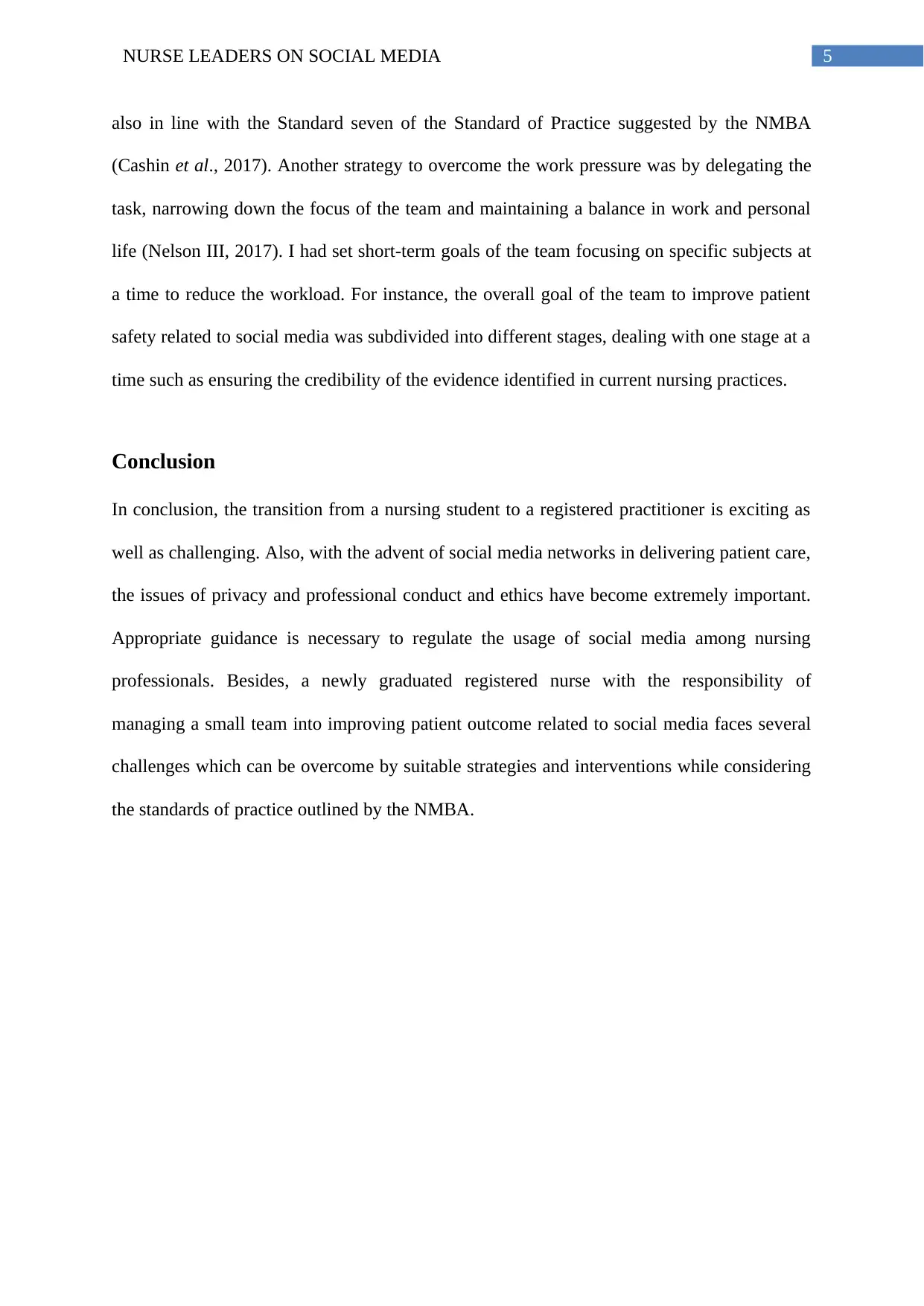
5NURSE LEADERS ON SOCIAL MEDIA
also in line with the Standard seven of the Standard of Practice suggested by the NMBA
(Cashin et al., 2017). Another strategy to overcome the work pressure was by delegating the
task, narrowing down the focus of the team and maintaining a balance in work and personal
life (Nelson III, 2017). I had set short-term goals of the team focusing on specific subjects at
a time to reduce the workload. For instance, the overall goal of the team to improve patient
safety related to social media was subdivided into different stages, dealing with one stage at a
time such as ensuring the credibility of the evidence identified in current nursing practices.
Conclusion
In conclusion, the transition from a nursing student to a registered practitioner is exciting as
well as challenging. Also, with the advent of social media networks in delivering patient care,
the issues of privacy and professional conduct and ethics have become extremely important.
Appropriate guidance is necessary to regulate the usage of social media among nursing
professionals. Besides, a newly graduated registered nurse with the responsibility of
managing a small team into improving patient outcome related to social media faces several
challenges which can be overcome by suitable strategies and interventions while considering
the standards of practice outlined by the NMBA.
also in line with the Standard seven of the Standard of Practice suggested by the NMBA
(Cashin et al., 2017). Another strategy to overcome the work pressure was by delegating the
task, narrowing down the focus of the team and maintaining a balance in work and personal
life (Nelson III, 2017). I had set short-term goals of the team focusing on specific subjects at
a time to reduce the workload. For instance, the overall goal of the team to improve patient
safety related to social media was subdivided into different stages, dealing with one stage at a
time such as ensuring the credibility of the evidence identified in current nursing practices.
Conclusion
In conclusion, the transition from a nursing student to a registered practitioner is exciting as
well as challenging. Also, with the advent of social media networks in delivering patient care,
the issues of privacy and professional conduct and ethics have become extremely important.
Appropriate guidance is necessary to regulate the usage of social media among nursing
professionals. Besides, a newly graduated registered nurse with the responsibility of
managing a small team into improving patient outcome related to social media faces several
challenges which can be overcome by suitable strategies and interventions while considering
the standards of practice outlined by the NMBA.
⊘ This is a preview!⊘
Do you want full access?
Subscribe today to unlock all pages.

Trusted by 1+ million students worldwide
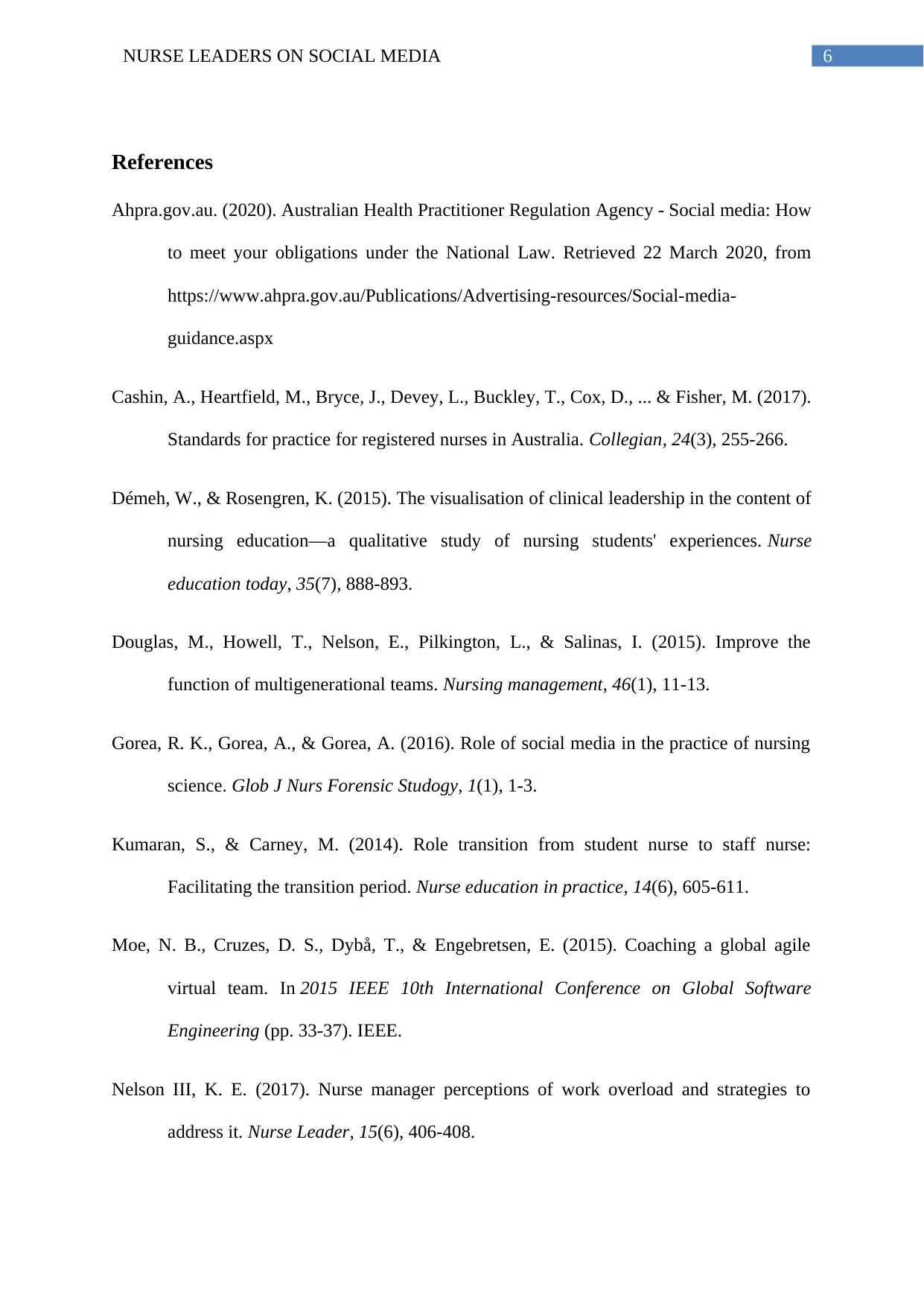
6NURSE LEADERS ON SOCIAL MEDIA
References
Ahpra.gov.au. (2020). Australian Health Practitioner Regulation Agency - Social media: How
to meet your obligations under the National Law. Retrieved 22 March 2020, from
https://www.ahpra.gov.au/Publications/Advertising-resources/Social-media-
guidance.aspx
Cashin, A., Heartfield, M., Bryce, J., Devey, L., Buckley, T., Cox, D., ... & Fisher, M. (2017).
Standards for practice for registered nurses in Australia. Collegian, 24(3), 255-266.
Démeh, W., & Rosengren, K. (2015). The visualisation of clinical leadership in the content of
nursing education—a qualitative study of nursing students' experiences. Nurse
education today, 35(7), 888-893.
Douglas, M., Howell, T., Nelson, E., Pilkington, L., & Salinas, I. (2015). Improve the
function of multigenerational teams. Nursing management, 46(1), 11-13.
Gorea, R. K., Gorea, A., & Gorea, A. (2016). Role of social media in the practice of nursing
science. Glob J Nurs Forensic Studogy, 1(1), 1-3.
Kumaran, S., & Carney, M. (2014). Role transition from student nurse to staff nurse:
Facilitating the transition period. Nurse education in practice, 14(6), 605-611.
Moe, N. B., Cruzes, D. S., Dybå, T., & Engebretsen, E. (2015). Coaching a global agile
virtual team. In 2015 IEEE 10th International Conference on Global Software
Engineering (pp. 33-37). IEEE.
Nelson III, K. E. (2017). Nurse manager perceptions of work overload and strategies to
address it. Nurse Leader, 15(6), 406-408.
References
Ahpra.gov.au. (2020). Australian Health Practitioner Regulation Agency - Social media: How
to meet your obligations under the National Law. Retrieved 22 March 2020, from
https://www.ahpra.gov.au/Publications/Advertising-resources/Social-media-
guidance.aspx
Cashin, A., Heartfield, M., Bryce, J., Devey, L., Buckley, T., Cox, D., ... & Fisher, M. (2017).
Standards for practice for registered nurses in Australia. Collegian, 24(3), 255-266.
Démeh, W., & Rosengren, K. (2015). The visualisation of clinical leadership in the content of
nursing education—a qualitative study of nursing students' experiences. Nurse
education today, 35(7), 888-893.
Douglas, M., Howell, T., Nelson, E., Pilkington, L., & Salinas, I. (2015). Improve the
function of multigenerational teams. Nursing management, 46(1), 11-13.
Gorea, R. K., Gorea, A., & Gorea, A. (2016). Role of social media in the practice of nursing
science. Glob J Nurs Forensic Studogy, 1(1), 1-3.
Kumaran, S., & Carney, M. (2014). Role transition from student nurse to staff nurse:
Facilitating the transition period. Nurse education in practice, 14(6), 605-611.
Moe, N. B., Cruzes, D. S., Dybå, T., & Engebretsen, E. (2015). Coaching a global agile
virtual team. In 2015 IEEE 10th International Conference on Global Software
Engineering (pp. 33-37). IEEE.
Nelson III, K. E. (2017). Nurse manager perceptions of work overload and strategies to
address it. Nurse Leader, 15(6), 406-408.
Paraphrase This Document
Need a fresh take? Get an instant paraphrase of this document with our AI Paraphraser
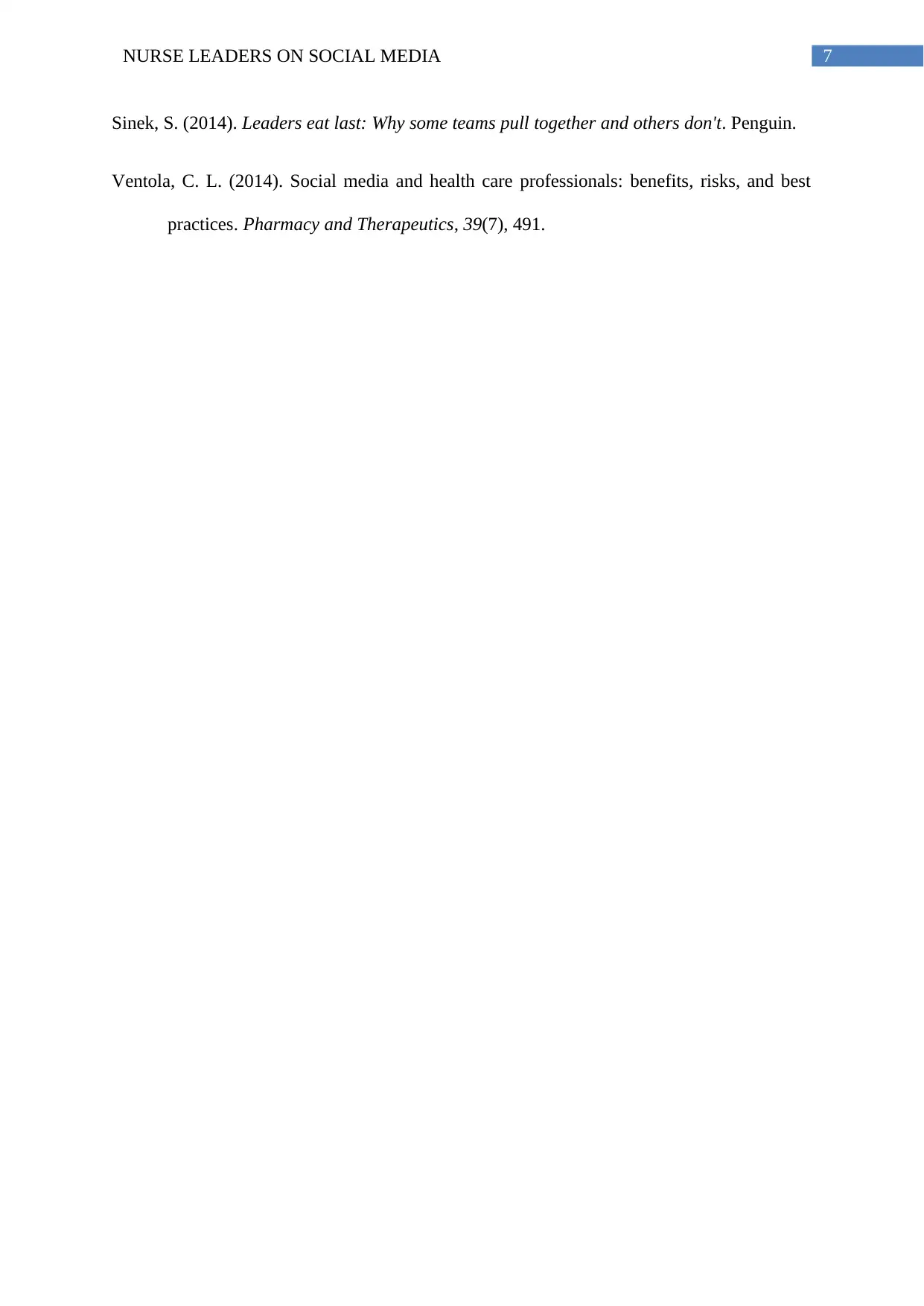
7NURSE LEADERS ON SOCIAL MEDIA
Sinek, S. (2014). Leaders eat last: Why some teams pull together and others don't. Penguin.
Ventola, C. L. (2014). Social media and health care professionals: benefits, risks, and best
practices. Pharmacy and Therapeutics, 39(7), 491.
Sinek, S. (2014). Leaders eat last: Why some teams pull together and others don't. Penguin.
Ventola, C. L. (2014). Social media and health care professionals: benefits, risks, and best
practices. Pharmacy and Therapeutics, 39(7), 491.
1 out of 8
Related Documents
Your All-in-One AI-Powered Toolkit for Academic Success.
+13062052269
info@desklib.com
Available 24*7 on WhatsApp / Email
![[object Object]](/_next/static/media/star-bottom.7253800d.svg)
Unlock your academic potential
Copyright © 2020–2025 A2Z Services. All Rights Reserved. Developed and managed by ZUCOL.





